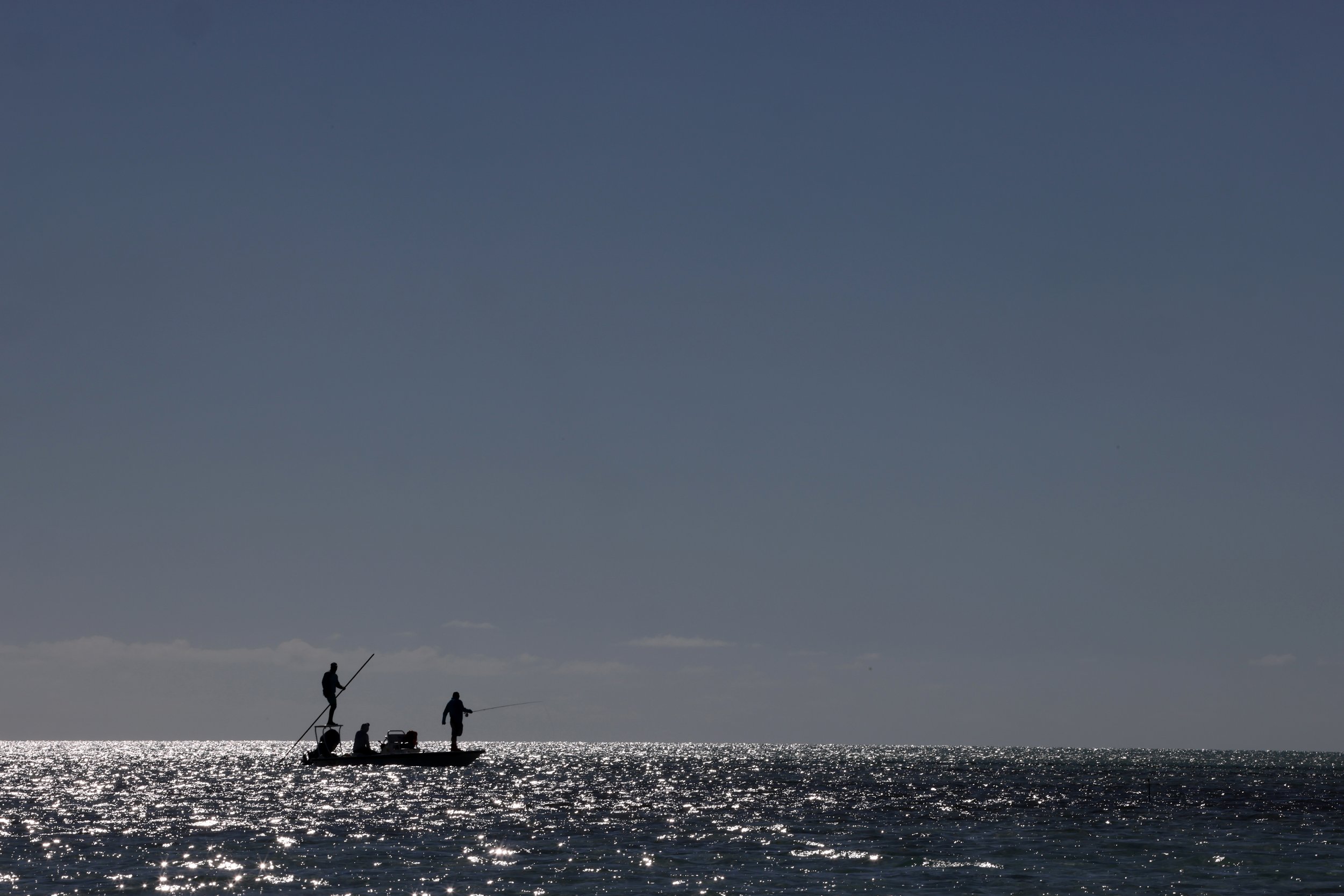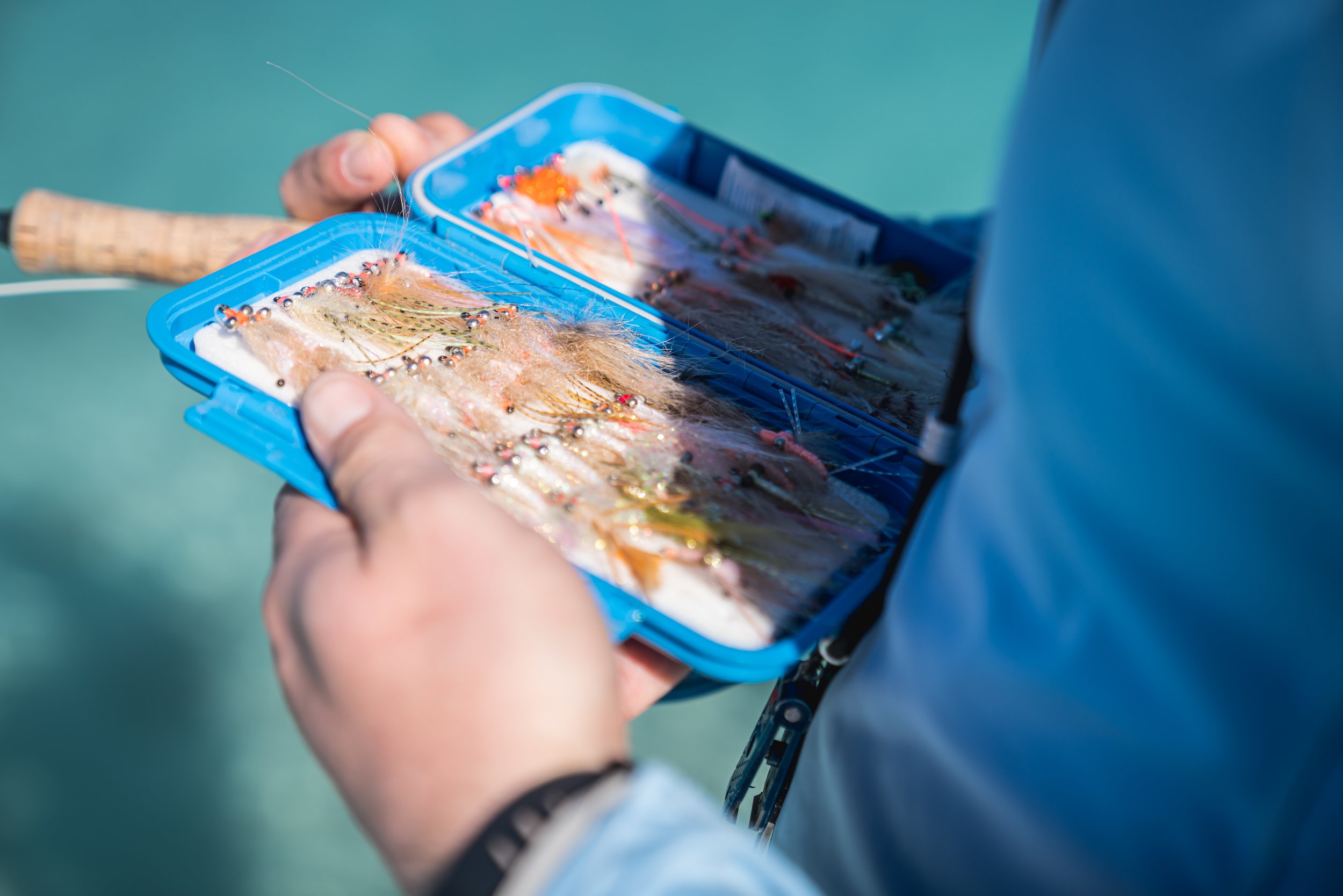Guide Development, Pt. I: Bait & Switch
Inherent within Soul Fly Lodge’s mission of “cultivating a deeper bond with our planet, the Berry Islands fishery and the local Great Harbour Cay community through consciously crafted angling adventures,” is the philosophy of constant improvement. When it comes to our angling and guest experience, our hospitality, and our connections to the local community, fishery, and natural world in general, we believe and embrace that our work is never done and we will always be learning. This credo is exemplified in our recent solar panel installation, Fish for Change week, and in our commitment to and investment in our guide team’s professional development, beginning with a clinic in “bait and switch” techniques.
It’s easy to visualize and get excited about the quintessential flats scenario: watching a big bonefish or permit cruise slowly across a shallow, light-sand flat for a hundred yards, stopping here and there to tilt down and feed, its forked tail breaking the glass-flat surface of the water. We all dream about these situations, but the reality is that they appear less frequently than we wish. Conditions simply do not always align perfectly, and this is why we encourage our guests to adopt and practice our Keys to Success. However, when conditions aren’t ideal and our favorite flats species aren’t as available or cooperative as we’d like, there is a less-explored and under-utilized fishery available to Soul Fly Lodge guests, just off the edge of the shallow water: the Bait and Switch game.
In September, Soul Fly Lodge hosted longtime Van Staal Sales Manager and Long Island guide Craig Cantelmo to help explore the Bait and Switch opportunities in the Berry Islands and work with our guide team on this technique. Craig has decades of experience in bait and switch techniques from his time striped bass fishing across the northeast, as well as frequent travels to the Bahamas and other tropical fisheries. In addition, his knowledge of both fly and spin fishing tackle makes him uniquely suited to explore, experiment, and share the approach with others. Together, Craig and the Soul Fly guides patrolled the edges of our flats as they drop off into deeper water, in search of the various types of structure such as points, rocky outcroppings, and coral reefs that hold fish species like mutton snapper, horse-eye jacks, grouper, and more.
As Craig put it, “The idea was to help introduce the Soul Fly guides to the technique so they have more options when the fishing is really tough and the wind is blowing. Additionally, bait and switch is a great way to manage the pressure on the bonefish and permit on the flats. When the fishing is great, taking some time to bait and switch gives the flats species a break and gives anglers more fun and exciting fishing.”
The Bait and Switch game is as follows: holding the boat an appropriate distance away from a shoreline or edge of a flat, the guide casts a hookless plug with a spinning rod on to or across the deep water structure; when the plug lands, the guide then retrieves it such that it mimics a wounded baitfish on the surface; the plug darts and dives and causes a general commotion which attracts and excites the fish laying beneath; these fish then follow or attack the plug, showing themselves to the guide and anglers; the angler is then charged with presenting a baitfish pattern quickly and accurately; ideally, the fly lands just in front of the plug and is retrieved immediately; the guide then accelerates the retrieval of the plug such that it overtakes the fly, leaving the pursuing fish with a clean shot at the fly; if the fly is being moved appropriately - subject to the fish’s reactions - they’ll take it, often savagely. Such a scenario takes place over the course of ten seconds or less and is, like all fishing situations, much easier described than performed when excitement is high.
“For bait and switch, positioning is critical,” says Cantelmo. “Both in terms of the boat relative to a shoreline or an edge of a flat, and also for the guide and angler in the boat. And, of course, the more you do it, the more proficient you get.”
For the angler, this technique requires a number of skills that translate extremely well to other scenarios, such as ultra-fast presentations, accurate fly placement relative to quickly-moving targets, fine-tuned retrievals that need to be catered to fish behavior, solid strip-sets, and effective fish-fighting. For the guides, boat placement is critical - both in terms of the distance from the structure, but also generally speaking because they need to learn which structure holds fish and when. Additionally, the hookless plug needs to be retrieved at delicate speeds: fast enough to attract the fish and hold the fish’s attention but not so fast that the fish will give up following it.
“The opportunities for bait and switch fishing are almost endless at Soul Fly,” Cantelmo said. “Just about every shoreline we went to, we raised fish.”
In terms of the target species, anglers can expect to encounter large and aggressive specimens of mutton snapper (up to 20 lbs), horse-eye jacks (up to 15 lbs), grouper (up to 10 lbs). Additionally, it’s always possible to be surprised as to what emerges from the depths. It’s not uncommon for Bait and Switch angler-guide teams to hook African pompano, cubera snapper, and barracuda. Part of the appeal of this technique is in the variety and overall size of species that can be caught.
There are many reasons to fish the Bait and Switch. Any angler will be amazed by the ferocious and explosive takes that these riled-up fish will display. For curious anglers, the technique also provides an exceptional learning opportunity and another way to increase overall angling skills. Depending on location, a few, quick Bait & Switch sessions can be added to a day on the flats while moving from one shallow-water area to another. And, for those days when fishing on the flats is especially challenging, this technique offers a way to keep fishing and have high-quality shots at exceptional fish.
We’re grateful to Craig for sharing his wisdom with us during his trip and we continue to look for opportunities to add to our guide team’s already-vast fishing expertise and wisdom. By being open to new angling methods, ways to teach, and ways to learn, we continue to improve. Ultimately this effort is beneficial in two ways: our guides remain challenged and engaged, and their expertise and abilities are always increasing; and, for our guests, the angling experience at Soul Fly Lodge gets better and better.
Read more on the Soul Fly Journal:













